

Reviw Article - Year 2013 - Volume 28 -
Sistematizacion and conduct of plastic surgery service of hospital geral de goiânia in mammoplasty in massive weight loss patients in last ten years
Sistematização e conduta do serviço de cirurgia plástica do hospital geral de goiânia em mamoplastia pós perda ponderal nos últimos dez anos
ABSTRACT
BACKGROUND: With the increase of the population obesity indices occurred a growth of the numbers of ex-obese patients and aesthetic/reconstructive plastic surgery in this population. Objectives: To present a systematic approach adopted in patients undergoing breast surgery after massive weight loss at Hospital Geral de Goiânia (HGG) in the last 10 years, and assess the results.
METHOD: We conducted a retrospective study of cases of breast surgery after massive weight loss in the Department of Plastic Surgery of HGG, from January 2002 to December 2011. The patients were individually analyzed preoperatively and submitted to the classification of Kaluf to breast dysmorphism after major weight loss. The operative technique varied depending on the classification of the type of breast.
RESULTS: The sample totaled 73 female patients, with mean age of 44 years and mean weight loss of 48 kg. In 41 patients (56.16%) was used the technique with inclusion of prostheses and in 32 (43.83 %) chose to not include silicone implants. Complications occurred in eight patients (10.95%), one case of hematoma (1.36%), two cases of suffering partial nipple-areola complex (2.73%), five cases of small suture dehiscence or delayed healing (6.84%) and one case of breast ptosis in the immediate postoperative period (1.36%).
CONCLUSION: Due to the wide range of dimorphisms in emaciated patients, in particular changes in their breasts, we note that it is necessary to establish protocols and routines for effective assessment and treatment, with the least possible morbidity, associated with better cosmetic results.
Keywords: Mammoplasty, Ex-obese, Plastic surgery
RESUMO
INTRODUÇÃO: Com o aumento dos índices de obesidade populacional ocorreu um crescimento do número de pacientes ex-obesos, e de cirurgias plásticas nesta população.
OBJETIVOS: Apresentar a sistematização e conduta adotada nos pacientes submetidos a mamoplastia, após grande perda ponderal, operados no Hospital Geral de Goiânia (HGG) nos últimos 10 anos, bem como avaliar os resultados obtidos.
Método: Foi realizado um estudo retrospectivo dos casos de mamoplastia após grande perda ponderal, operados no Serviço de Cirurgia Plástica do HGG, de janeiro de 2002 a dezembro de 2011. As pacientes foram analisadas individualmente no pré-operatório e submetidas à classificação de Kaluf, para dismorfias mamárias após grande emagrecimento. A técnica operatória variou em função da classificação do tipo de mama.
RESULTADOS: A casuística totalizou 73 pacientes, do sexo feminino, com faixa etária média de 44 anos, e perda ponderal média de 48 Kg. Em 41 pacientes (56,16%) foi utilizada a técnica com inclusão de próteses, e em 32 (43,83%) optou-se por não incluir os implantes de silicone. As complicações ocorreram em oito pacientes (10,95%), sendo um caso de hematoma (1,36%), dois casos de sofrimento parcial do complexo aréolo-mamilar (2,73%), cinco casos de pequenas deiscências de sutura ou retardo de cicatrização (6,84%) e um caso de ptose de mama no pós-operatório imediato (1,36%).
CONCLUSÃO: Devido à grande variação de dismorfismos em pacientes emagrecidos, em especial as alterações mamárias, notamos que se torna necessário o estabelecimento de protocolos e rotinas para avaliações e tratamentos eficazes, com a menor morbimortalidade possível, associados aos melhores resultados estéticos.
Palavras-chave: Mamoplastia, Ex-obeso, Cirurgia plástica
The incidence of obesity has currently increased dramatically, with 40% of Brazilian women and 30% of Brazilian men considered obese. The number of ex-obese patients has also increased owing to gastroplasty or nutritional diets.
Plastic surgeons have started working on this area of aesthetic and corrective surgery, wherein patients present specific features concerning their skin and subcutaneous tissues in addition to systemic alterations and comorbidities, which require integration with other specialties and professionals to ensure adequate patient support.
Several body deformities are observed when a patient undergoes massive weight loss, including breast dysmorphisms, which are frequently caused by atrophy and/or breast ptosis. In such cases, the patients may present with flaccid and less elastic skin due to edema and rupture of the collagen fibers in the dermis (Figures 1 and 2).
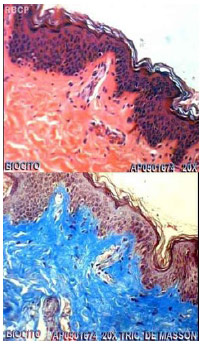
Fig. 1. Histological features of the normal skin
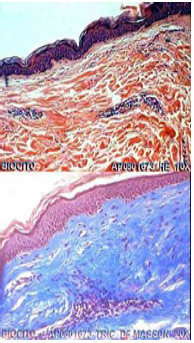
Fig.2 Histological features of the skin of an ex-obese patient
OBJECTIVES
To describe the systematization and management of patients who experienced massive weight loss after they underwent mammoplasty at the Hospital Geral de Goiânia (HGG) within the last 10 years and to analyze the results.
METHODS
After approval by the ethics committee, we conducted a retrospective study of patients who experienced massive weight loss after they underwent mammoplasty at the Plastic Surgery Service of the HGG between January 2002 and December 2011.
The study included patients with morbid obesity who had experienced massive weight loss (>40%) after mammoplasty, with or without the use of prosthetic devices.
The patients were evaluated individually during the preoperative assessment and classified into three groups according to the amount of breast tissue, ptosis, and breast asymmetry (Figures 3-5).
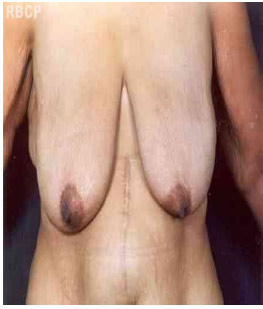
Fig.3 Type I breast
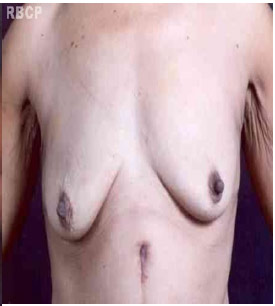
Fig.4 Type II breast
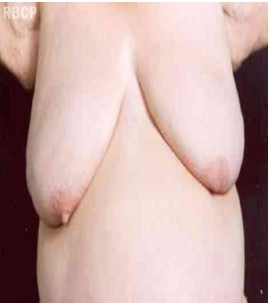
Fig.5 Type III breast
The selected surgical technique varied according to breast type, as shown in Table 1 and Figures 6-11.
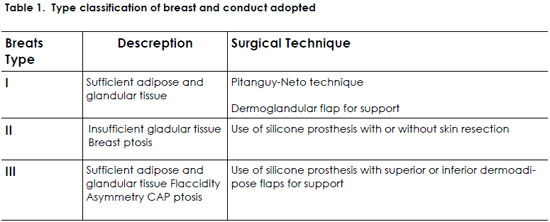
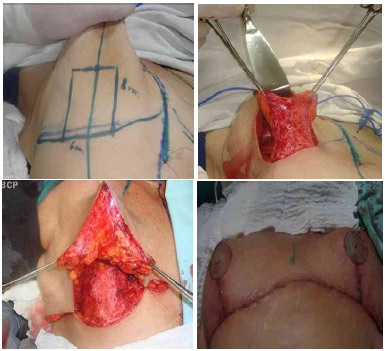
Fig. 6 Corrective surgery on a type I breast: marking as per the Pitanguy-Neto technique using the Liacyr inferior flap .
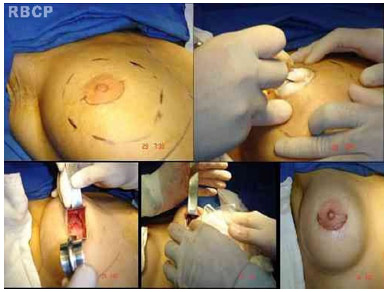
Fig. 7 Corrective surgery on a type I breast: preparation of the inferior flap.
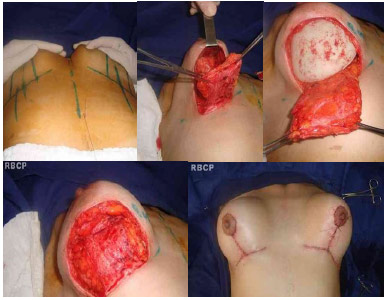
Fig. 8 Corrective surgery on a type I breast: mounting of the breast.
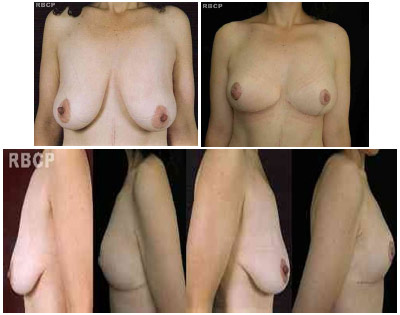
Fig. 9 End result of the corrective surgery on a type I breast
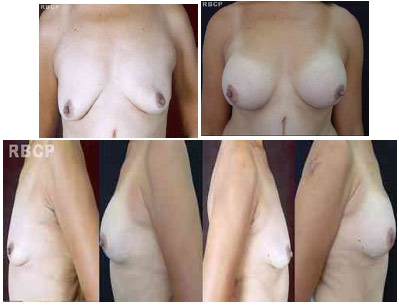
Fig. 10 Corrective surgery on a type II breast: marking, dissection, and insertion of a polyurethane prosthesis using a periareolar incision
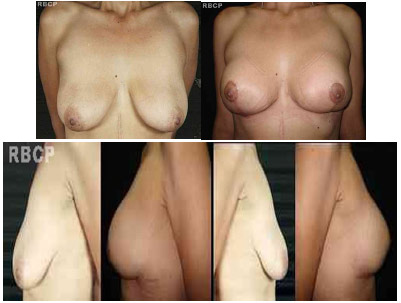
Fig. 11 Corrective surgery on a type III breast: marking of the inferior pedicle for prosthesis
RESULTS
A total of 73 female patients (mean age, 44 years; range, 21-68 years) and weight loss of 48 kg (31-75 kg) were included in this study.
Prosthetic devices were used in 41 patients (56.16%), whereas a choice was made not to use silicone-based implants in 32 patients (43.83%), as illustrated in Figures 20-37.
Complications occurred in eight patients (10.95%), including one case of hematoma (1.36%), two cases of partial damage (between 15% and 25%) to the nipple-areola complex (2.73%), five cases of small dehiscences along the sutured lines or delayed healing (6.84%), and one case of breast ptosis during the immediate postoperative period (1.36%).
DISCUSSION
Patients who experienced massive weight loss should be followed up by an interdisciplinary team, as they require specific evaluations and treatments owing to peculiarities and alterations in various organ systems, which must be identified and controlled in order to provide the best results and to reduce incidence of complications.
Considering the complexity and great number of clinical alterations that occur in ex-obese patients, we adopted specific protocols to manage such patients who attend the Plastic Surgery Service of the HGG, including the timing of surgery and the minimal inclusion criteria, which are associated with preoperative tests and evaluations, that patients should meet to qualify for surgery.
Standard mammoplasty procedures were adopted for ex-obese patients, which varied according to the patients' breast types. Because the surgical strategy and technique are predefined during outpatient consultation, the procedure can be performed with greater safety in a shorter duration, and with better postoperative outcomes.
CONCLUSION
The increase in the number of ex-obese patients has led to a parallel increase in the number of aesthetic/corrective procedures performed by plastic surgeons in this patient group. Therefore, plastic surgeons should have better knowledge of the peculiarities and alterations that occur in a person's body after massive weight loss.
Considering the broad range of dysmorphisms observed in our patients after massive weight loss, especially in relation to the breast area, we conclude that establishment of routine evaluation protocols and the use of effective therapies to minimize morbimortality as much as possible while providing the best aesthetic results are necessary.
REFERENCES
1. Castro CC, Aboudib JH, Coelho RFS, Gatorno M. Conceituação sobre as mamaplastias e mastopexias. Rev Soc Bras Cir Plast. 2002;17(3):19-26.
2. McKissoc PK. Reduction mammaplasty with a vertical dermal flap. Plast Reconst Surg. 1972;49(3):245-52.
3. Pitanguy I. Breast hypertrophy. In: Anais do II Congress of International Society of Plastic Surgeons. Londres, Inglaterra; 1959.
4. Ribeiro L, Backer E. Mastoplastia com pedículo de seguridad. Rev Esp Cirug Plast. 1973;6:223-34.
5. Strombeck JO, Mammaplasty in hypertrophy of the female breast. In: III Congress Transaction International Society of Plastic Surgery. Washington, USA; 1967.
6. Ariê G. Una nueva técnica de mastoplastia. Rev Latinoam Cir Plast. 1957;3(1):23-31.
7. Bustos RA. Periareolar mammaplasty with silicone supporting lamina. Plast Reconst Surg. 1992;89(4):646-57.
8. Rees TD. An historical review of mammaplasty. Anais do Transact Fifht Intern Cong Plast S; Austrália.
9. Carramaschi FR, Tanaka MP. Mastopexia associada à inclusão de prótese mamária. Ver Soc Bras Cir Plast. 2003;18(1):31-6.
10. Carreirão S, Cardim V, Goldenberg D. Cirurgia plástica. São Paulo: Atheneu; 2005.
11. Cardoso JH. Tratado de Cirurgia Plástica na Obesidade. Rio de Janeiro: Editora Rúbio. 2008.
12. Lima Jr EM. Tratado de Cirurgia Plástica Após Grandes Perdas Ponderais. São Paulo: Atheneu. 2011.
1. Full member of the SBCP, Preceptor of the Plastic Surgery Service of the HGG and Regent of the Obesity Surgery Chapter of the SBCP
2. Specialist Member of the SBCP, Chief of the Plastic Surgery Service of the HGG
3. Specialist member of the SBCP, plastic surgeon
4. Specialist member of the SBCP, plastic surgeon
5. Aspiring member of the SBCP, resident physician in plastic surgery of the Hospital Geral de Goiânia
6. Aspiring member of the SBCP, resident physician in plastic surgery of the Hospital Geral de Goiânia
Waldivino Guimarães Filho
Rua 55, nº 520, apto 2403, st. Jardim Goiás
CEP 74810-230, Goiânia-GO
e-mail: WGF222@bol.com.br
Article received: 22/04/2012
Article accepted: 01/07/2012
HOSPITAL GERAL DE GOIÂNIA - DR. ALBERTO RASSI


 Read in Portuguese
Read in Portuguese
 Read in English
Read in English
 PDF PT
PDF PT
 Print
Print
 Send this article by email
Send this article by email
 How to Cite
How to Cite
 Mendeley
Mendeley
 Pocket
Pocket
 Twitter
Twitter